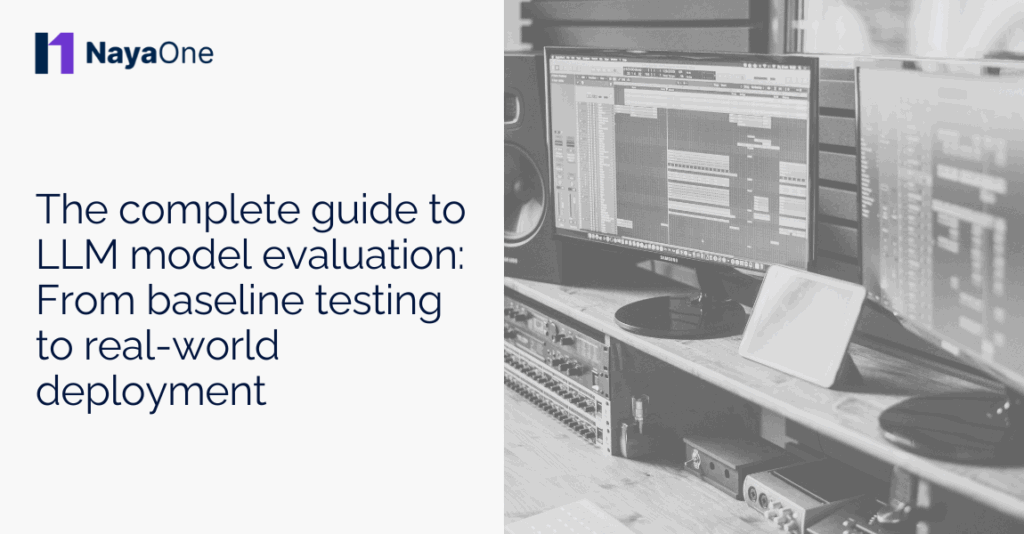So, you’ve got a powerful, large language model on your hands. Maybe it’s designed to generate regulatory summaries, detect anomalies in transaction logs, or help financial advisors decode complex investment portfolios. Sounds impressive, right? But before that model goes anywhere near a production system, there’s one key question: how do you know it performs safely, consistently, and in line with compliance standards?
That’s where LLM model evaluation comes in. It’s the bridge between building an impressive model and deploying one that you, and your regulators, can trust. This process isn’t just about meeting baseline performance; it’s about ensuring your LLM won’t produce hallucinations, deliver misleading financial insights, or breach sensitive risk thresholds.
We’ll walk through every stage of the model evaluation, from foundational assessments to live-environment simulation, through the lens of financial technology. Whether you’re a machine learning engineer, product owner, or compliance analyst, you’ll find a clear roadmap for putting your LLMs to work with confidence.
What does LLM model evaluation really involve?
Let’s start with the basics. Evaluating an LLM is like testing a new risk model: it has to be accurate, transparent, and aligned with real-world expectations. Except in this case, you’re not just crunching numbers; you’re dealing with natural language that must meet both human and regulatory standards.
In a financial setting, LLM model evaluation means checking how well the model performs across specific use cases, whether it’s parsing a term sheet, interpreting ESG disclosures, or answering client questions about pension rules. This evaluation spans intrinsic metrics (like grammar, coherence, and syntactic fluency) and extrinsic outcomes (like factual precision in summarising a central bank report).
For example, if your LLM is summarising quarterly earnings calls, intrinsic evaluation might focus on fluency and sentence structure. But extrinsic testing would measure whether it picks up on key financial risks, like revised earnings guidance or regulatory investigations.
You’ll often need input from domain experts. A model might sound confident when interpreting IFRS changes or compliance rulings, but that doesn’t mean it’s right. The model evaluation in finance requires a mix of automated testing and subject-matter review to safeguard against false confidence.
Which metrics and benchmarks actually matter?
You’ve probably come across BLEU, ROUGE, or perplexity scores. They’re helpful for general NLP tasks, but let’s be honest, they don’t tell you if your model is giving sound investment recommendations or missing crucial AML red flags.
In financial services, LLM model evaluation needs to be far more contextual. If your model is classifying SWIFT messages, you’ll prioritise accuracy, recall, and false positive rates. But if it’s helping clients understand insurance exclusions, you care more about clarity, completeness, and regulatory alignment.
Bias and fairness matter too, especially in lending, underwriting, and wealth management. A seemingly neutral LLM might reflect real-world biases from its training data. You’ll want to evaluate whether different user profiles receive consistent responses. In financial services, unfair outcomes aren’t just unethical; they’re regulatory liabilities.
There are macro-benchmarks like HELM, MMLU, or TruthfulQA that provide a general view of performance. But for fintech use cases, they’re not enough. You’ll need to develop industry-specific test sets, like collections of prospectuses, fraud scenarios, or compliance FAQs, to gauge real-world reliability. Generic tests are a starting point; domain-tuned benchmarks are where the real work begins.
How do you move from testing to trusted deployment?
Let’s say your model passed a range of benchmarks. That’s a strong start. But real-world use is a different game, especially in financial tech, where precision and auditability are non-negotiable.
Here’s where LLM model evaluation shifts from static testing to dynamic simulation. Create testbeds that mimic your operating environment. If your model will face unstructured trading notes, multilingual KYC documents, or chatbot queries from retail investors replicate that noise. Inject incomplete data, edge-case scenarios, or sudden regulatory updates to see how the model reacts.
Human-in-the-loop testing is crucial. Assign financial analysts, risk officers, or client service teams to score and flag outputs. This isn’t just QA; it’s a feedback loop that helps you refine prompts, reinforce guardrails, or tweak model fine-tuning.
Explainability is also vital. If your model recommends a portfolio shift or flags a suspicious transaction, can it justify that decision in plain terms? You’ll need this for internal trust and external compliance. Without it, you risk running into pushback from legal or audit teams.
In a post-AI regulation world, especially with the EU AI Act and UK proposals gaining ground, audit trails aren’t optional. You’ll need records of how your model was tested, what risks were identified, and what mitigations were applied. Treat model evaluation as part of your risk management framework, not just a technical exercise.
Can LLM evaluation keep up with the pace of model development?
Here’s the hard truth: LLMs are evolving faster than most governance strategies can keep up. One month you’re working with GPT-4, the next you’re evaluating Claude or fine-tuning your own financial model on Bloomberg datasets. So how do you avoid starting from scratch every time?
The key is making LLM model evaluation continuous. Build automated pipelines that track each iteration, test performance against live datasets, and alert you to performance regressions. Use synthetic prompts to model tail-risk events, say, a market crash or a liquidity crunch, and see how your model holds up.
LLM evaluation is no longer a step in the QA process, it’s a delivery dependency. That’s why forward-thinking institutions are adopting Vendor Delivery Infrastructure (VDI) like NayaOne: a shared, compliant sandbox-as-a-service that lets any team source, test, and ship AI and fintech capabilities at enterprise scale.
NayaOne’s sandbox approach lets you test LLMs using real financial APIs, datasets, and third-party integrations. That means you’re evaluating performance not in theory, but inside an operational fintech ecosystem.
You’ll also want to align your evaluation tools with your model architecture. Open models like LLaMA 3 or Mistral offer deep control but require you to build your own testing infrastructure. Closed systems like GPT or Claude often provide basic evals, but you’ll still need custom layers for financial use cases.
Whichever route you take, your evaluation process needs to flex with your business goals. Did the FCA change its disclosure guidelines? Did your product pivot from B2B to retail? Your evaluation framework must adapt just as quickly.
Is your organisation ready to evaluate LLMs responsibly?
By now, it should be clear: LLM model evaluation is not a side task. It’s a foundational part of responsible AI deployment in financial services, impacting everything from product trust to regulatory alignment.
So ask yourself: have you defined what success looks like for your LLM? Are your metrics tied to business outcomes and compliance thresholds? Have you tested in lifelike conditions and brought in the right human reviewers? Do you have explainability and traceability baked in? And most importantly, can your process scale with future model updates?
If you’ve got strong answers, you’re well ahead of the curve. If not, it’s time to invest in a stronger evaluation infrastructure. That might mean partnering with model governance experts, spinning up a private sandbox, or adopting a sandbox as a service solution that enables secure, repeatable testing workflows using financial-grade data and conditions.
Tools like NayaOne make it easier to validate your models without risk. You can plug into fintech APIs, access real use case templates, and test performance before your model ever hits production. In a space where precision, safety, and speed all matter, that’s a serious advantage.
In financial services, LLMs are the new frontier. But without the right infrastructure, they stay trapped in slide decks and endless PoCs. NayaOne’s VDI turns evaluation into execution, so LLMs go from promising demos to production-ready capabilities.
With NayaOne, evaluation isn’t a checkpoint; it’s your go-to-market engine. From model testing to full vendor deployment, NayaOne bakes in data controls, compliance alignment, and repeatable workflows that remove delivery drag across every business unit.
Just as CI/CD became the standard for code, VDI is becoming the operating system for external digital capabilities. NayaOne powers that shift.





